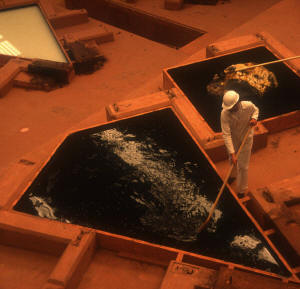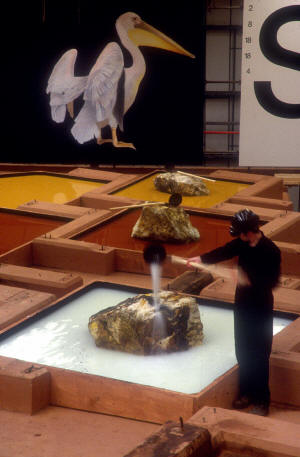|
|
|
| home | features | exhibitions | interviews | profiles | webprojects | gazetteer | links | archive | forum | |
|
Glen Onwin On 'Blood of the Pelican', installed at Geevor mine, 1997, as part of 'A Quality of Light': the first of three large-scale events organised by St Ives International.
|
|
|
Mostly the natural sciences, geological science, the meaning of and in matter - what could be called natural philosophy. Also place, process, the psychological meaning and understanding of place. That's how place is affected by man, and man by place, and the evolution of place and the processes at work in the making and meaning of place. I am also interested in the detail and the
whole and how one reflects the other. I am fascinated by opposites
hot/cold, wet/dry, black/white, open/closed. I also explore the
conjunction of opposites and the edges and interface of this conjunction.
I am interested in how people are effected by place and matter itself.
Consequently I have for decades been interested in ancient sciences, early
chemistry, the myths of creation and the art of alchemy.
Regarding the work at Geevor, the interests are evident in the work but they are also evident in my other large scale installations. That said Geevor was uniquely suited to my practice both in a mythic sense and a practical, historic and industrial sense. Extracting ore from the earth can be seen as (is) a mythological process.
'Blood of the
Pelican' was a large and ambitious project that
took place in Geevor mine, which presumably had been unused for
several years by 1997. Did the human figures in the pictures remain
for the entire duration of the work? What were
they doing? The scrap men had plundered the large room where my work was installed, they had removed all the newest steel shaking tables as scrap metal. The mined ore was separated from its matrix on shaking tables in photographs you can see the oil stains from the motors which drove these machines clearly visible on the pink tin ore covered concrete. The concrete shapes/blocks which made up the solid walls of the kite and square shaped tanks are the foundations of the shaking tables. I simply joined them up with timber to form solid walled tanks , the shape of the tanks comes from these foundations.
Can you explain the
symbolism of the coloured water, the Pelican and
the letters 'Sr'? Is this something that was
explained to visitors or was it left to their
own interpretation? The colours have alchemical significance. All these elements also have significance either to Geevor Mine itself or to the local industries and culture of Cornwall, even referencing Bernard Leech. The pelican is a scanna-chrome print on canvas. The bird was drawn by an artist who gave me permission to use it. The pelican was originally drawn for the Collins Book of Birds. He stands 15 feet from head to foot in the print. The pelican is in Geevor, in fact in the museum of the mine ( Geevor is a heritage site). The pelican can be found on the tin stamp which identified where the tin originates. Geevor's trade mark logo was a lamb and flag. The flag has the form of a cross and this is an obvious Christian symbol. Historically in order to sell tin in non Christian countries another image/trade mark had to be used, they chose a less obviously Christian symbol: the pelican.
On the right Sn a contemporary scientific symbol for tin with related technical and elemental data hence the numbers. Most visitors saw the work after visiting the Geevor museum and readily associated the image of the pelican with Geevor tin.
Did you get to see
much of the rest of 'A Quality of Light', and do you
remember much about it? Can you think of similar regional arts
events that have successfully generated interest
and press coverage because this remains an
ongoing issue for us in Cornwall. It was great to be involved in such a
project.
'The best work in this show is by Glen Onwin - a marvellous installation in Geevor Tin Mine - which has only the most tangential connection with the subject of light. Even the artist sounds apologetic when he says it's about conceptual light; one must think of the miners emerging from the pit into daylight or night. In fact, Onwin's intervention refers to the methods of separating tin ore from crushed rock, using water and vibrating tables. A terraced installation of square and kite-shaped tanks (one black with coal, another white with china clay, the next red with oxide of tin ore, the last yellow with ochre), overlooked by a giant pelican, celebrates a mystical meeting of industry and alchemy. It's unusual and impressive'. Andrew Lambirth (The Spectator)
|
|


